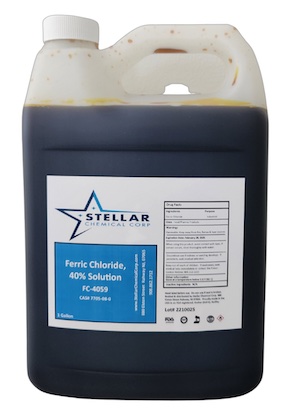
-----
Waste treatment in zinc plating
Q. Our company paints and Zinc plates automotive parts. We usually segregate the waste water from both the departments. But by accident, all the water got mixed up, and now we are having problems with the precipitation of Zinc. By the way, we use hydroxide precipitation to remove metals. We have been able to get down the Zinc concentration to 4 ppm using various chemicals, but not any lower than that. Our discharge limits are 2.61 (daily) and 1.48 (monthly).Various chemicals we tried : caustic soda, Lime, Magnesium oxide, ferrous sulphate , Calcium chloride, Sodium borohydride, Calcium polysulfide, two proprietary organometallic polymers. Any suggestions will be highly appreciated. Thanks in advance.
prasad s [surname deleted for privacy by Editor]information service
1995
A. I assume these values are after filtration, Prasad?
If not, your problem is easily solved -- you need to clarify or filter the wastewater.
My personal experience is that sulfide chemistry is often the most powerful precipitating method for zinc, like calcium polysulfide, DTC (sodium diethyl dithiocarbamate) or Degussa's proprietary TMT15.
For this one-time troublesome batch, I suggest trying to lower the pH to about 5 and loading it up with your ferric chloride
⇦ on
eBay or
Amazon [affil link] before raising the pH for the hydroxide precipitation. Filter out the precipitated zinc. Now treat the filtrate with the proprietary co-precipitant and the polysufide, DTC or TMT15. Naturally, do jar testing of this idea committing the whole batch. before Good luck.

Ted Mooney, P.E.
Striving to live Aloha
finishing.com - Pine Beach, New Jersey
Ted is available for instant help
or longer-term assistance.
Q. Dear Mr. Mooney :
Thank you for your reply. I forgot to mention, but we tried the carbamate too. Yes, we are filtering the effluent. Since my last letter, we had successfully precipitated out zinc using Magnesium Oxide and a proprietary organometallic polymer 326-C. But now we are having problem removing Nickel. This is not caused by 326-c. We had the problem with Nickel to start with. One more chemical we tried in the last couple of days is ferric chloride
⇦ on
eBay or
Amazon [affil link] at around pH 8.0. Please suggest any chemicals to remove Nickel and at what pH, they work best. Thanks again for your reply.
-Prasad.
information service
1995
A. Hi, Prasad.
1). When you describe all these things they you have tried, they hopefully were each tried on small samples of the waste. You should not attempt treating the whole batch without lab scale beaker [beakers on
eBay
or
Amazon [affil link] tests first to verify that they work, or you will end up with a large volume of witches' brew that already contains large amounts of a dozen different precipitants, and it just keeps getting harder and harder to treat.
2). After some of the metal has precipitated out, you must get rid of it by filtering it before going on to deal with the remaining dissolved metal. If the precipitated metal remains in the batch you are working with, constantly ready to redissolve into equilibrium, you may never get there. The strong sulfur based precipitant will remove a molecule of zinc, but if the waste was not filtered, a molecule of formerly hydroxide precipitated zinc just goes back into solution to replace it. So you must hydroxide treat, filter it, and then sulfide treat only the remaining unprecipitated zinc and nickel.
3). In general, nickel precipitates best at high pH, about 10.5. When magnesium hydroxide is used for the treatment of nickel it has to be 'topped off' with caustic or another stronger alkali because magnesium hydroxide doesn't get the pH high enough. See letter 565 for starters.
4). You need a treatment sequence and strategy, not a hunt for a miracle precipitant. For example: lower the pH, add ferric chloride
⇦ on
eBay or
Amazon [affil link] , raise the pH, add flocculant, and filter out most of the zinc. Now you take the clear effluent and raise the pH further to remove the nickel, and filter it. Now you are left with a few ppm of zinc or nickel still in solution, and you add a few ppm of a powerful sulfur based precipitant to precipitate it.
It is probably unaffordable and environmentally hazardous to try to remove the bulk of the metal with strong sulfides like polysulfide or DTC! The worst pollution incident in the history of the electroplating industry (White River, Indiana) had nothing at all to do with a plating process or a discharge of untreated or under-treated plating waste … rather it was a gross over-discharge of the wastewater treatment chemical DTC.
Good luck!

Ted Mooney, P.E.
Striving to live Aloha
finishing.com - Pine Beach, New Jersey
Ted is available for instant help
or longer-term assistance.
A. Try 3 separate tanks, bring the pH to about 6.5 in the first tank while adding the ferric chloride ⇦ on eBay or Amazon [affil link] ; then in the second tank raise the pH to about 9.2-9.5 try aluminum sulphate in this tank; then in the 3rd tank (typically a smaller tank then the first 2) meter in the polymer and run through a clarifier/filter press. There are many things to take into consideration … the flow of the water and how fast the coagulant/flocculant chemicals are feeding, I do not deal with nickel but our effluent numbers are usually below 1 mg/l.
Jake Skinner- Clinton, Iowa, U.S.
May 2, 2013
Q. We're having trouble producing a true solid from our waste treatment of electrozinc rinsewaters. We have a typical chemical precipitation process. Our sludge is too wet, more of a slurry at times. We have tried alum and lime. No major improvements. Has anyone used potassium permanganate ⇦ on eBay or Amazon [affil link] with any success? Someone has suggested this, but I've not heard of it? What about hydrogen peroxide? I'm leery of both of these, but would welcome comments.
Karen Walters- Lexington, Kentucky
1999
A. Please don't mess around with unconventional, perhaps dangerous, treatment technologies unless there is a demonstrated need. You do have a filter press, I assume -- you're not expecting the material to precipitate as a solid without dewatering? Second, what zinc process do you use: cyanide, alkaline, chloride zinc, ammoniated zinc?

Ted Mooney, P.E.
Striving to live Aloha
finishing.com - Pine Beach, New Jersey
Ted is available for instant help
or longer-term assistance.
A. I'm not sure what kind of bath your waste is from. The general procedure for zinc waters is adjusting the pH to 9.0 - 9.3, and then using a flocculant to make settleable solids. Personally, I have not had a lot of luck with lime treatment of zinc plating wastewater. If you are treating the rinses from an acid chloride zinc bath, adding a little at the start of the treatment may help. I would do most of the pH adjustment with 50% caustic soda ⇦liquid caustic soda in bulk on Amazon [affil link] , though. Some ferrous sulfate ⇦ on eBay or Amazon [affil link] might help, too. The fact that you mention permanganate and peroxide makes me think that you are treating a cyanide waste. Both of these chemicals have their uses in cyanide treatment, but only in special circumstances. And, neither will have any effect on cyanide that is not amenable to chlorination. This type of cyanide needs to either be precipitated, or destroyed with special techniques, such as UV irradiation.

Dave Wichern
Consultant - The Bronx, New York
A. I would suggest that you try some beaker [beakers on eBay or Amazon [affil link] tests using magnesium hydroxide. It is moderately insoluble and there is a great tendency to add too much, causing the pH to rise as time goes on, possibly causing a discharge problem as well as wasting product. It gives a considerably more granular precipitate. Consider using it for the bulk of the neutralization and then finish with sodium hydroxide or lime. Beaker testing and then 5 gal bucket testing is a wise way to proceed before committing bigger dollars.
James Watts- Navarre, Florida
A. There is no problem precipitating zinc hydroxide, even from the cyanide solution (once the cyanide is treated). If the sludge is too slimy using sodium hydroxide, switch to hydrated lime. Leave to settle and run through the filter press. The cake will be in a dry "biscuit" form, especially if your filter press has the facility to blow air through once the cake is formed and ready to be taken out.
Q. Unfortunately our problem only starts there. Since the new environmental laws have come into operation we can no longer dump zinc hydroxide or zinc dust ⇦ on eBay or Amazon [affil link] from vibropolishing onto hazard dumps. We need help! Anybody with ideas as to what we can do with it is welcome. Regards Trudy
Trudy Hattingh- Durban, South Afica
1999
A. Dear Ms. Hattingh:
Here in the U.S. we have some "recycling" of zinc sludges. I write "recycling" in quotes because when a hauler has to charge more to recycle something than to dispose of it in a secure landfill, one has to question whether this is true recycling or just a "feel good" exercise in semantics and obfuscation that consumes more natural resources than it saves. If you are not allowed to dispose of zinc wastes in a secure landfill, and cannot establish recycling of zinc sludges in South Africa, I guess you have to contract to landfill it in another country--an environmental disgrace that countries like the U.S. and Canada are already involved in.

Ted Mooney, P.E.
Striving to live Aloha
finishing.com - Pine Beach, New Jersey
Ted is available for instant help
or longer-term assistance.
A. Are you also treating your cleaner rinses and dragging a lot of oil and cleaner into the water? I recently started up a Micro Filtration system for Zinc sludge rejection and they occasionally had upsets when they dragged to much cleaner and oils into the water and as the previous replies recommended Ca or Mg ties it all and forms a nice pin floc.
John Ring- Wheaton Illinois
Q. Hello again, I am still looking for help in stabilising zinc hydroxide effluent sludge to be able to dispose of it on a low hazard dump. Can you help? Regards Trudy
Trudy Hattingh [returning]- Durban, South Africa
1999
Q. First I had a solution of zinc chloride and a small amount of MnCl2, could you suggest me how to separate in a form hydroxide metals between Mn and Zn.
I would be very grateful if you could give me some explanation.
Tri BudionoCollege Student of Indonesian University - Jakarta, Indonesia
2001
Best Wastewater Treatment for Alkaline Zinc Nickel Plating
Q. We will run an alkaline zinc nickel alloy plating installation in a few months. We have limit of 1 ppm for Zn and Ni in the wastewater dumped at the sewer. What is your opinion on the treatment of the waste water from the lines to achieve 1 ppm for both metals. I am interested if I can do this using chemical precipitation or do I need special installations like ion exchange resigns, electrocoagulation, UV-oxidation, etc.
Thanks
Electroplating - Sebes, Romania
March 18, 2013
A. Hi. Maybe another reader will disabuse me of my error, but I wouldn't trust my future to getting 1 ppm from a simple hydroxide precipitation system, even with additions of Calcium, Aluminum, or Iron co-precipitants. I just don't think you will consistently achieve it.
I think you'll need to plan for secondary treatment with sulfide or DTC. This means you first treat with hydroxide precipitation and a co-precipitant, settle out the precipitants in a clarifier, and then treat just the clarified effluent with sulfide or DTC and filter or clarify it again. Be very careful to not overdose these. In the USA, the worst pollution incident from a plating shop wasn't a discharge of inadequately treated or even untreated waste, but a gross overdose of a treatment chemical (DTC) which killed 4-1/2 million fish over a stretch of 50 miles (google "Guide fish kill White River Indiana"). Sometimes the cure really is worse than the disease :-)
Regards,

Ted Mooney, P.E.
Striving to live Aloha
finishing.com - Pine Beach, New Jersey
Ted is available for instant help
or longer-term assistance.
A. Hello Ionut,
You can achieve, as Ted mentioned, lower than 1 ppm by a chemical treatment with DTC, sulfide or other chemical precipitant. We, at the moment, are using tertiary polyamines (cationic coagulant) and polyacrylamides (anionic flocculant), sodium sulfide and sodium hydroxide. We get zinc values of 0,1-0,7 ppm and nickel 0,1-0,2 ppm with this system.
I would ask for some assistance to make an installation for this wastewater treatment, and be very meticulous in the mixing systems: Low mixing and you will not be able to control your process (dosing, precipitation and pH adjustment), high mixing and you will have very small floccules and the precipitation will take some time (in a continuous plant you may have some problems with the size of the sedimentator).
Hope you can achieve your goal! Regards and good luck!
- Cañuelas, Buenos Aires, Argentina
Q. Dear Sir
Being a mechanical engineer I want to know from you how to treat the wastewater coming out from zinc electroplating. What are the chemicals used in the process
engineers - Delhi, India
August 22, 2013
A. Hi Shree. First, are you sure that this is alkaline non-cyanide zinc electroplating? Acid zinc and cyanide zinc are quite different. Are you using trivalent chromating? Is the pretreatment limited to alkaline soak cleaning, electrocleaning, and muriatic acid activation, or are there other steps? There are no other wastes mixed in, and there is currently no wastewater treatment?
Regards,

Ted Mooney, P.E.
Striving to live Aloha
finishing.com - Pine Beach, New Jersey
Ted is available for instant help
or longer-term assistance.
Q. May I know the removal efficiency for the BOD in chemical precipitation process and removal efficiency for Zinc at carbon filter for zinc coating waste water treatment. I require this information for mass balance calculation.
zulkarrnaen ahmad- Johor, Malaysia
July 30, 2018
A. Hi Zulkarrnaen. Sorry, but I don't think you can receive even a wild estimate for that question.
To my knowledge chemical precipitation would not be used for BOD removal and carbon filtration would not be used for zinc removal. Perhaps you have transposed something and you are planning on chemical precipitation for zinc, and carbon filtration for BOD?
For a first cut, you can probably use the effluent limitations as a guideline for zinc removal by precipitation because in much of the world they are supposedly based on what the regulators feel is possible. In other words, they think chemical precipitation will get the zinc down to 2 ppm or 4 ppm or whatever the regs in your area say.
Apologies but I could not begin to hazard a guess about BOD removal by carbon filtration.
Regards,

Ted Mooney, P.E. RET
Striving to live Aloha
finishing.com - Pine Beach, New Jersey
Ted is available for instant help
or longer-term assistance.
Readers may also be interested in this related thread:
• Topic # "Zinc plating wastewater? Best pH?"
Q, A, or Comment on THIS thread -or- Start a NEW Thread
